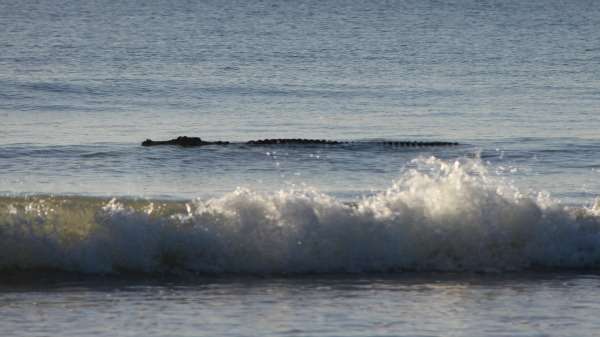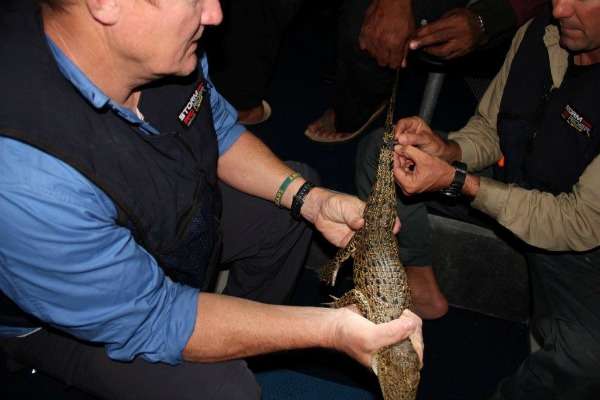A crocodile surfing the waves at Cable Beach in February 2014. Credit: Sharon Scoble
Rebounding saltwater crocodile (Crocodylus porosus) populations in the north Kimberley which are increasingly venturing into human-populated areas are raising the chances of tourists and locals having spine-tingling encounters with these fear-inducing creatures.
Researchers and Traditional Owners traversed the spectacular reaches of the Prince Regent, Hunter and Roe rivers at night to discover that croc numbers have trebled from 30 years ago when hunting had decimated their numbers.
They counted the crocodiles by torchlight, the beam of torchlight reflecting off the crocodiles' eyes gleaming from dark waters.
The surveys revealed a healthy croc population, comparable to crocodile numbers in the crocodile-rich waters of the Northern Territory, according to WA Department of Parks and Wildlife (DPAW) scientist Andrew Halford.
However, the increase in crocodile numbers combined with warming waters are pushing crocodile populations further south to tourist areas such as Broome, he says, thereby posing new challenges for conservation managers seeking to keep people safe.
"We've got a situation where there will be more and more human and crocodile interaction and that's clearly a management issue that we need to keep an eye on," Dr Halford says.
"In the news the other day we had a couple of big crocs at Cable Beach that would have posed a serious threat to beachgoers so they were removed and taken to a crocodile park."
Some crocodiles in tourist locations in remote areas have lost their fear of humans and pose an elevated risk to visitors, Dr Halford says.
Taking a biopsy sample from a small crocodile. Credit: Andrew Halford
Such crocodiles are usually killed, while crocodiles in more accessible areas are translocated away from human populations—a difficult, dangerous and expensive operation.
As part of the surveys the team counted the crocs from a five-metre aluminium boat specially adapted for crocodile surveys, with higher-than-standard safety rails and non-reflective black paint on the hull to prevent spotlight reflections.
The team felt privileged to work in such a spectacular setting, Dr Halford says, though there were certain encounters that left their hearts racing.
"Sometimes we'd be in these little creeks at night time in the middle of nowhere and you'd see a really large croc," he says.
"Usually they just disappear but sometimes, when they are not too happy you're there, they'll come towards you at quite a rate."
The Dambimangari, Willingin and Wanambal Gaambera Traditional Owners helped conduct the surveys as part of a bigger plan to enable traditional owners to take over the monitoring of plants and animals in their own country.
Provided by Science Network WA
This article first appeared on ScienceNetwork Western Australia a science news website based at Scitech.
























